AAES School and College News
The following is news from our AAES-affiliated schools and colleges. For more information on the teaching, research, outreach or development activities of any of these academic units, contact them directly at their respective phone numbers or Web sites.
Honorees Announced for 2005 IQLA
Auburn University's College of Human Sciences (CHS) has announced that the Hugh L. Carey Battery Park City Authority (BPCA) is the recipient of the 2005 International Quality of Life Award. BPCA owns and manages Battery Park City, a 92-acre planned urban community built on ground that was excavated to construct the World Trade Center Twin Towers. The award ceremony will take place on Dec. 5 at the United Nations in New York City.


Ratan Tata, above, chairman of the Tata Group,
will be honored at the International Quality of Life
banquet this year, along with the Hugh L. Carey
Battery Park City Authority in New York. Battery
Park City is shown on the right.
Battery Park City is located at the southwestern tip of Lower Manhattan in New York City. In less than 30 years, it has emerged from a downtown area plagued by deterioration and poverty to a vibrant neighborhood that serves as a model blueprint for the urban community of the 21st century. Specifically, Battery Park City is an example of how visionary and skillful planning can lead to the creation of a sustainable community that carefully balances its use of commercial, residential, retail and open spaces to promote an "environmentally friendly" lifestyle for the individuals and families within its borders. Over the years, the Authority has garnered numerous awards for its outstanding achievements in architecture, design and sustainable development.
Most amazing, however, is Battery Park City's triumphant resurgence after the devastation created by the attacks on the World Trade Center in September 2001. The community, which was evacuated immediately after 9/11 and remained partially closed for many months thereafter, is once again thriving commercially and is now home to more residents than ever before. Under the leadership of the Battery Park City Authority, the neighborhood continues its commitment to "green living" with the construction of some of the nation's most environmentally-responsible residential buildings and the opening of new public park spaces and cultural attractions.
Battery Park City has truly "risen from the ashes" and is a life-affirming symbol to the world of the strength, compassion and resiliency of the human spirit. In the words of Timothy Carey, Battery Park City Authority's president and CEO, "We're back and we're better than ever."
In addition to honoring the 2005 laureate, a second International Quality of Life Award (deferred from 2004) will be presented to Ratan Tata, chairman of the Tata Group, one of the largest corporate conglomerates in India. Rapidly becoming a major force in the global marketplace, the Tata Group's portfolio includes steel and automobile manufacturing, telecommunications, hotels, tea, insurance, mutual funds and management consulting.
Known in international business circles for its high ethical standards and focus on social responsibility, the Tata Group serves as an exemplary model of corporate philanthropy. Committed to "improving quality of life," it is truly noteworthy that 66 percent of the conglomerate's profits are given back to the people of India in a wide range of efforts related to education, health, arts and culture and environmental sustainability.
Ratan Tata joined the Tata Group in 1962 and worked his way through the ranks at Tata Steel, Tata Motors and Tata Consultancy before being appointed chairman in 1991. He holds a bachelor's degree from Cornell University and completed an advanced management program at Harvard University.
Tata serves on the boards of numerous organizations within India and throughout the world. Included among them are the Mitsubishi Corporation, the American International Group, JP Morgan Chase, the Rand Center for Asia Pacific Policy, the Bill and Melinda Gates Foundation's India Aids Initiative and the Ford Foundation. In January 2005 Forbes named Ratan Tata "Asian Businessman of the Year," and Businessweek described his dynamism as the "force that catapulted an honest and conservative Indian conglomerate into the global big leagues."
Craig-Schmidt Presents at International Symposium on Trans Fatty Acids
Margaret C. Craig-Schmidt, professor of Nutrition and Food Science, was an invited speaker at the First International Symposium on Trans Fatty Acids and Health held in September in Copenhagen, Denmark. The topic of Craig-Schmidt's address was Worldwide Consumption of Trans Fatty Acids.
The three-day symposium was sponsored by the Danish Nutrition Council, an independent publicly financed scientific organization, that is playing a prominent role in trans fatty acid research and the clarification of issues surrounding its consumption in the diet. Craig-Schmidt was one of 20 presenters addressing an audience of leading nutrition scientists from around the world.
Craig-Schmidt holds the Ph.D. degree in physiological chemistry from the University of Wisconsin-Madison. She joined the AU faculty in 1977. Her research focus is lipid metabolism with an emphasis on infant and maternal nutrition.
CHS Faculty Taking AU Administrative Positions
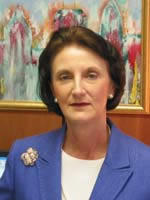
Associate Dean Dotty Cavender
Three College of Human Sciences (CHS) faculty members have been tapped for administrative positions at Auburn University.
CHS Associate Dean for Academic Affairs Dotty Cavender has been named acting associate provost for academic affairs. CHS Human Development and Family Studies (HDFS) Professor Joe Pittman has been named acting associate dean of the AU Graduate School. And Donna Sollie, also a professor of HDFS, is serving as special assistant to the AU provost for Women's Leadership.
Cavender will devote half of her time to the new position while devoting the other half to her continued responsibilities as the CHS's associate dean for academic affairs and associate professor of consumer affairs. In addition to his duties in the Graduate School, Pittman will continue to serve as professor of HDFS. Sollie also continues to serve in her HDFS role.
AU Vets Help Provide Animal Care after Hurricane Katrina
A team of Auburn University veterinarians has been making trips to Baton Rouge, La., to assist in the care of animals affected by Hurricane Katrina.
"Nine of our veterinarians are helping provide shelter and care for pets that have traveled with their owners from flooded areas and for rescued animals," said David Whitley, head of AU's Department of Clinical Sciences in the College of Veterinary Medicine (CVM). "Dean (Timothy) Boosinger is pleased to provide support, and the university administration is giving them time off for the trip."
The dean of the Louisiana State University School of Veterinary Medicine sent a request in early September to veterinary schools and associations seeking assistance. CVM volunteers include Julie Waldrop, Herris Maxwell, Soren Rodning, Jennifer Taintor, John Schumacher, Mary Lynn Higginbotham, Jeffery Simmons, Lisa Tieber-Nielson, Earl Gaughan and other veterinarians and technicians who have the opportunity. They travel in groups of three to six for each trip, with the number being determined at the time. The first group assisted Sept. 14-17.
Public donations can be made to the Louisiana Veterinary Medical Association by calling 1-800-524-2996 or (225) 928-5862. A donation form is also available at its Web site at www.lvma.org. Checks or money orders can be made payable and sent to the Walter J. Ernst Jr. Veterinary Memorial Foundation (write Disaster Relief Fund on the memo line), 8550 United Plaza Blvd., Suite 1001, Baton Rouge, LA 70809.
New Raptor Amphitheater to Open this Fall
The College of Veterinary Medicine's Southeastern Raptor Center will dedicate a new amphitheater Nov. 17, providing a place for educational programs about birds of prey.
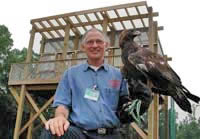
Education Specialist Roy Crowe of
Auburn University's Southerneastern
Raptor Center holds golden eagle.
Nova in front of a 25 foot flight tower
in the center's new amphitheatre.
The 300-seat facility has two 25-foot towers for flight demonstrations and is being funded by a $300,000 gift from Carol Clark of Princeville, Ill. It will provide more opportunities for local residents as well as out-of-town guests to see a raptor program. It will also reduce travel time and costs for the Center's two education specialists, who travel across the region presenting programs to schools, conservation groups and other organizations. They have spoken to almost 72,000 students in the past year and a half.
Programs can cover not only raptors, but also related topics such as wildlife conservation, the physics of flight and customized programs tailored to specific groups or events. For example, a bald eagle is used to combine a program on raptors and Memorial Day.
The Center's most famous residents are 27-year-old golden eagle Tiger, officially known as War Eagle VI, bald eagle Spirit and golden eagle Nova. All birds used in the educational programs are non-releasable due to prior injuries or human imprinting. Any bird capable of surviving in the wild must be released, according to the U.S. Fish and Wildlife Service, which permits Auburn to house the birds.
For information about the dedication or the Center's educational programs, call 844-6943. To report an injured raptor, call 844-6347.
Calvin Johnson Named Head of Department of Pathobiology
AU Professor Calvin Johnson has been named head of the Department of Pathobiology in the College of Veterinary Medicine (CVM).
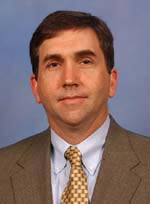
Dr. Calvin Johnson
"He has done an excellent job as a teacher and researcher, and will now be instrumental as department head," says Timothy Boosinger, CVM dean. "He grew up in Auburn, went to school here and has had many accomplishments in his career."
Johnson joined the Auburn faculty as a professor in 2003 after serving 11 years at the University of Florida, where he had advanced to associate chairman of its Department of Pathobiology. A 1979 graduate of Auburn High School, Johnson earned his bachelor's degree in 1983 and his veterinary degree in 1986, both from Auburn University. He earned his Ph.D. in veterinary immunology from North Carolina State University in 1992.
He is the son of Mr. and Mrs. Wiley C. Johnson of Auburn; his father is an emeritus professor of agronomy in the College of Agriculture.
Historic Photos Sought for Alabama Veterinary History Book
Auburn University's College of Veterinary Medicine (CVM) is seeking photographs from the early to mid-1900s for a commemorative book that will be printed in 2007, a key year in the history of veterinary medicine in Alabama.

Auburn's first veterinary class in 1909 poses for its class photo.The veterinary program started in 1892 and became a college in 1907.
It will mark the 100th anniversary of the Alabama Veterinary Medical Association, the CVM and Auburn's Annual Veterinary Conference.
Auburn's veterinary program began in 1892 and became a college in 1907, the same year the Alabama Veterinary Medical Association started. Photos are also being sought related to Tuskegee University's establishing of its veterinary college in 1945. Photos could include veterinarians, clinics, animals, vehicles, equipment—anything that shows the history of veterinary medicine.
Anyone wishing to submit photos should contact Gary Beard or Charles Martin at 334-844-3699. Photos mailed to them will be scanned and returned within a few days. Anyone not wanting to send originals can have the photos reproduced at a local photo developer, such as a discount retailer or drug store, and then submit the duplicates by mail or e-mail.
To Extend Research, Education and Outreach A Brand New Start
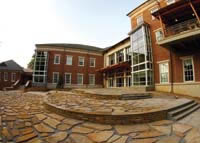
View of new forestry building from the interior courtyard.
It all began more than a decade ago with the dream that students in the School of Forestry and Wildlife Sciences (SFWS) should have better facilities to learn about our natural environment. After years of hard work by hundreds of people and almost $25 million from generous donors, the dream became a reality on Aug. 26, 2005, when the doors of the brand new SFWS building opened to hundreds for tours of the facility and a dedication ceremony.
For the approximately 400 students that will use this facility, 602 Duncan Drive starts a new chapter for forestry and wildlife majors. Counting all the graduates put together from forestry and wildlife sciences, more than 3,000 students dedicated their time to the study of forestry and wildlife sciences prior to the opening of this facility.
SFWS Dean Richard W. Brinker described it best, as a "red-letter day in the history of our school."
According to Brinker, the Alabama Legislature in 1945 passed an act creating a four-year professional forestry program. Two years later, the program was given departmental status at Auburn University and, in 1984, it was declared a separate school.
The idea of constructing a new building was first discussed more than 10 years ago; however, appropriate funding was not available at that time, so the design process stalled. It only took one donation to get the momentum rolling again. In 1998 U.S. Senator Richard Shelby directed a $10 million grant through the U.S. Forest Service to build and design what would soon be the new building for Forestry and Wildlife Sciences at Auburn University. Soon after that, the Alabama Agricultural Bond Initiative provided $7 million coupled with $500,000 from Auburn University to the construction of the facility. The remaining funds came from 44 major, private donors. SFWS Professor Glenn Glover has chaired this committee since 1992.
Proof that the dream would become reality was seen on Nov. 8, 2002—groundbreaking day for the new facility. Under construction management by Brasfield & Gorrie and designed by the architectural team of Infinity Architects and Cooper-Carry, the building took almost three years to construct.
The SFWS building features labs, walk-in coolers, technology-enhanced rooms and computer labs that are practically three times the size of those in the previous building. Backed by a natural forest, the new building has four wings and a connecting 3,000-square-foot foyer between them. Its majestic atrium is appropriately made from southern yellow pine.
During the ceremony, James Martin, past chairman of the forestry advisory council, called the building a credit to the forestry and wildlife community and applauded everyone involved in the project for their ability to "never give up."
Interim Auburn University President Ed Richardson said that this building is an asset for current students, but may also be a drawing card for future applicants. Richardson noted that, though this may be one of Auburn's smallest schools, it has huge potential to gain greater national visibility. "It makes up a major part of our state's economy. It has a very bright future," he said.
Pointing out that forest resources are one of the true treasures of Alabama, AU Board of Trustee member Virginia Thompson spoke about the financial impact of Alabama's forests and wildlife. "Forests make up 71 percent of our state," declared Thompson. And, informing everyone that they consume a 100-foot-tall tree a year, Thompson talked about the added impact that forestry has that outsiders may not see.
"I vow to you that we will do everything in our power to strengthen and build your business further. We will take in unknown knowledge, and our students and faculty will do everything they can to improve the quality of life for every Alabamian," said Thompson.
"I applaud all of you in the audience," said Brinker as he closed the ceremony. "I hope we continue to strive to be the premiere Forestry and Wildlife Sciences School in the country."
Honorable Mention at Annual Meeting
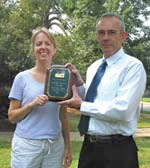
Rachel Jolley (left), a Ph.D, student in the School of Forestry and Wildlife Sciences, received the honorable mention award for best presentation at the annual national meeting of the Society of Wetland Scientists in Charleston, S.C., in June. Her presentation was entitled “The effects of sedimentation on forest health and productivity in riparian forests associated with ephemeral streams.” Jolley is currently working on her Ph.D in forestry under the direction of Graeme Lockaby.
Students Begin Classes in New Sciences Center Complex
When AU's fall semester classes began on Aug. 15, the first College of Sciences and Mathematics (COSAM) students were welcomed to the new COSAM Sciences Center, a new facility that features such enhanced academic facilities as virtual laboratories for 3-D simulations, wireless PDAs for real-time classroom participation and flat-panel plasma screens for sharp instructional imaging.
Coming from the Sciences Center Auditorium after her first class at Auburn, freshman Ellen Thomas remarked, "It's so nice. I really liked the projection screen—I've never been in a classroom that big before, so it was really exciting."
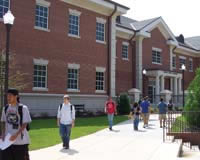
First day of classes at the new Sciences Center.
Freshmen pre-med students Dana Wiesenfeld and Ashley French said they loved the new facilities and agreed that the stadium seating in the auditorium was one of the things they liked best.
The COSAM Sciences Center has been hailed as the Southeast's premiere sciences center complex. Loaded with state-of-the-art features, it includes a two-story classroom/administrative building, a 300-seat auditorium and a four-story biology/chemistry laboratory building.
Around the AAES
Logging On
Today's highly mechanized timber harvesting systems have greatly increased the efficiency of harvesting large tracts of timber, but those large-scale efficiencies disappear on small tracts of 50 acres and under. Consequently, many small-tract forestland owners have been left with no means of harvesting and no market access for their timber.
In Alabama's Black Belt, this situation has created a paradox: an abundance of a prized natural resource-timber-in a region that is characterized by persistent rural poverty and substandard housing.
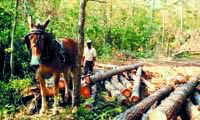
That combination of factors is the inspiration behind an innovative project that three AAES scientists including a rural sociologist, a forester and an ag economist—and the head of the AU School of Architecture's highly acclaimed Black Belt–based Rural Studio program (www.ruralstudio.com) —have launched in west Alabama.
"We're asking the question: What can we do to better integrate local resources with local needs," says Conner Bailey, the rural sociologist on the project.
The research team's goal in west Alabama is to identify and promote economical, small-scale harvesting systems, such as ones using farm tractors or horses and mules, as well as scale-appropriate wood-processing technologies—e.g., portable sawmills—that would produce valuable building materials Rural Studio students could use to build homes for families currently living in substandard housing.
Funded by a $460,000 USDA grant, this project will extend to other regions in Alabama and the South where forestland is divided into large numbers of small tracts.
In addition to generating income and employment and producing building materials, the project will help owners of small parcels thin their pine stands and thereby reduce the threat of Southern pine bark beetle infestations.
Rawls Elected to RCAS
Randall Rawls, superintendent of the Upper Coastal Plain Research Center in Winfield, has been elected to serve in the officer rotation for the Research Center Administrators Soci-ety (RCAS). He served as secretary last year (2004), is currently vice president and program chairman (2005) and will become president in February 2006 at the conclusion of the RCAS national meeting in Orlando, Fla.
RCAS is a national organization of research center superintendents, directors and/or managers with common goals and interest in managing the operation of off-campus agricultural research stations. Its membership represents approximately 35 states from all parts of the U.S. except the New England states.Current membership, totaling more than 100, includes representation from land-grant universities, state Departments of Agriculture and USDA-ARS research stations with interests in all disciplines within and related to agriculture
RCAS has two meetings each year. Its winter meeting is held as part of the SAAS meetings each February. The summer meetings are held at various locations across the U.S. in a more informal setting with hands-on experiences and observations of what is being done by other states and institutions in other regions of the country.
Making Scents
When it comes to moths and mating, it's all a matter of scents. Females emit chemical substances, called pheromones, that attract male moths. Once they mate, they lay eggs on crops' leaves or fruit. When the eggs hatch, the larvae start munching away , leading to the need for pesticides.
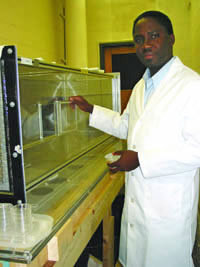
Henry Fadamiro tests pheromones
in a six-foot-long wind tunnel.
In his lab at Auburn, AAES entomologist Henry Fadamiro is out to nip this problem in the bud by uncovering ways to disrupt the mating rituals of moths, specifically those that attack cabbage, collards, tomatoes, corn, cotton and various tree fruit crops.
He is formulating synthetic pheromone blends and testing them by putting the pheromones in one end of a six-foot-long wind tunnel and releasing a male moth at the other end, downwind of the substance. If the blend is correct, the male will make a beeline toward the source.
The synthetic pheromones can either be used in traps to monitor moth populations so that farmers will know when to apply insecticides, or they can be used to disrupt mating by releasing the scents from numerous sources in a field. This confuses the males so that fewer can locate real females. If they don't mate, they can't procreate, and the need for pesticides drops.
Fadamiro is also studying an environmentally sound "attract-and-kill" tactic that uses pheromones to lure moths to specific areas in a crop field, where they are killed with a toxicant. That eliminates the need for blanket pesticide applications.
No Longer Knocking Out Nematodes
For more than 30 years in their battle against root-destroying nematodes, cotton farmers have relied on the pesticide aldicarb, known commercially as Temik, for a good six weeks' worth of inexpensive control.
But in recent years, Temik hasn't been knocking out root-knot nematodes like it used to. What once worked for six weeks isn't lasting six days. What's up with that? Have the nematodes become resistant?
No, says AU plant pathologist Kathy Lawrence. What's happened, her research shows, is that soil bacteria have evolved to the point where they can break the nematicide down quickly. Alternative nematicides are available, but at a cost of more than double Temik.
Lawrence and AU soil scientist Yucheng Feng have applied for a patent on a lab process that will test growers' soil and rapidly let them know how fast Temik will break down in their fields.
Armed with that information, producers can decide whether to stick with Temik, switch to costly alternatives or follow Lawrence's other findings in the study, which indicate that rotating cotton fields to corn for two years reduces the rate of aldicarb degradation in the soil.
A Double Shot of CO 2
The concentration of carbon dioxide (CO2) in the atmosphere is increasing and expected to double in the next century.
A group of AAES and USDA scientists in Auburn is determining what impact this change in global climate will have on Southern longleaf pine forests.

Preliminary findings show that the pines flourish under elevated CO2 levels, growing faster and denser, with more branches and needles.
That enhanced growth, however, appears to come at the expense of other tree species, plants and grasses in the forests, says AAES researcher and AU plant anatomist Roland Dute, who notes that, in the long run, forest diversity will be lost.
And while faster-growing pines will shorten the number of years to bring trees to the market, this could result in an oversupply that would depress timber prices, he says.
Chinese Delegation Visits Sister State
The State of Alabama welcomed 12 officials from the Province of Hubei, China, in September in a celebration honoring a 20-year Sister State-Province relationship between the two entities.
The Province of Hubei sent the delegation to Alabama in honor of the long-term relationship involving cultural exchange and economic development cooperation. The relationship was initiated by Gov. George Wallace in 1985. Alabama and Hubei have shared academic exchanges and are also working on technology exchange agreements.

Gov. Bob Riley, left, thanks Zhu Chunxuan,
right, and He Shiping for a hand-painted Chinese
proverb. Zhu Chunxuan is head of the Friendship
Delegation of Hubei Province of China and He
Shiping is deputy director- general of the Hubei
Provincial Foreign Affairs Office.
Delegation members visiting Alabama included Zhu Chunxuan, vice chairman, standing committee of Hubei Provincial People's Congress; Chen Hongbo, vice secretary-general, General Office of Hubei Provincial People's Congress; He Shiping, deputy director-general Hubei Provincial Foreign Affairs Office; Zou Linde, deputy director-general Hubei Provincial Commission for Development and Reform; Ye Taijun, vice chairman, Enshi Autonomous Regional People's Congress; Yue Xingping, mayor, Zaoyang City, Hubei Province; Chen Bin, deputy division director, General Office of Hubei Provincial People's Congress; Dai Guizhou, director-general Hubei Provincial Academy for Agricultural Science; Li Yonghong, deputy division director/interpreter, Hubei Provincial Foreign Affairs Office; Jiao Chunhai, specialist on rice, Fang Xiangliang, specialist on kiwi fruit, and Bie Shu, specialist on cotton, Hubei Provincial Academy for Agricultural Science.
While in Alabama, the delegation attended business meetings with companies interested in doing business with Hubei as well as toured Auburn University and visited with CoAg Dean and Alabama Agricultural Experiment Station Director Richard Guthrie.
Grant Check
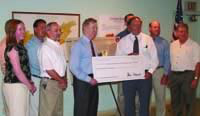
U.S. Rep. Robert "Bud"Cramer (D-Ala.) stopped by the Tennessee Valley Research and Extension Center in Belle Mina in August to drop off a little checkÑ—a $604,000 check to be precise. The check comes from a grant that Cramer secured to support research and extension activities in Alabama focusing on precision agriculture and forestry. The grant provides funds for projects that are developing new GPS- and GIS-based technology to help Alabama farmers and forest landowners remain competitive. Cramer (third from the left) presented the check to CoAg Dean and Alabama Agricultural Experiment Station Director Richard Guthrie (fourth from left). Also on hand for the presentation were faculty and administrators from CoAg's departments of biosystems engineering and agronomy and soils, the U.S. Department of Agriculture's state offices and the Alabama Cooperative Extension System, all of which are involved with the projects.

